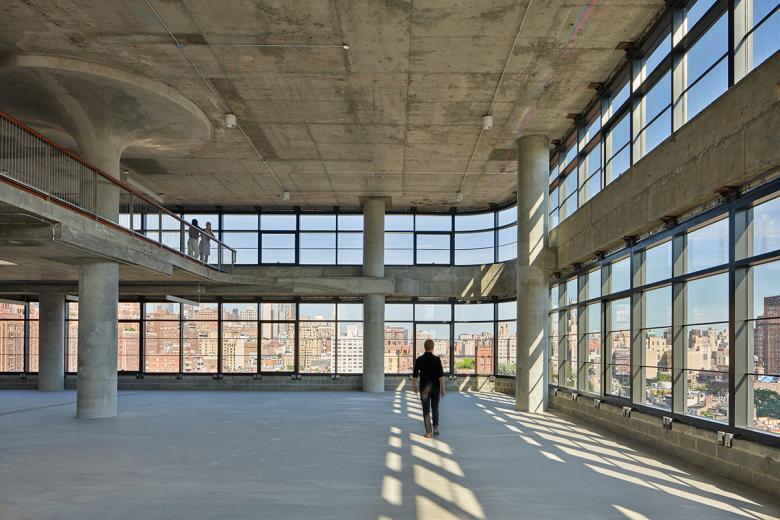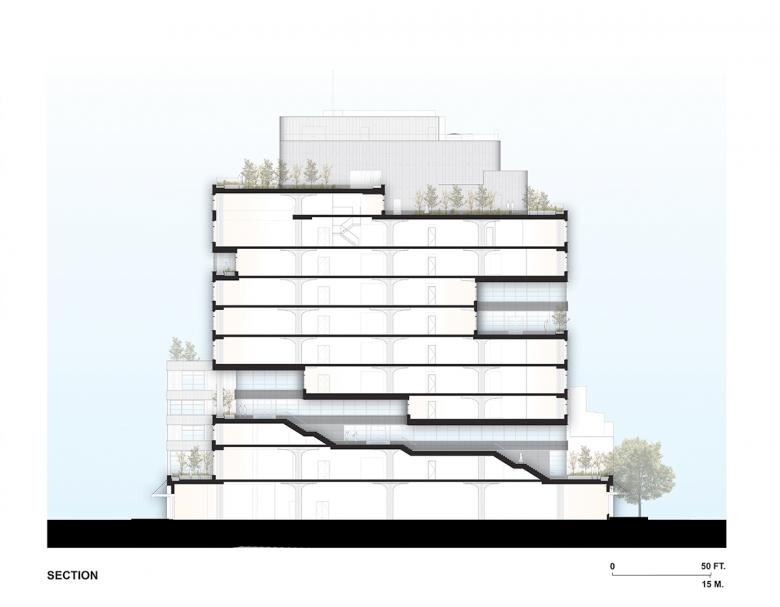U.S. Building of the Week
512 West 22nd Street
COOKFOX
8. June 2020
Photo: Bruce Damonte
The world-famous High Line park has spawned much development on Manhattan's West Side since it opened in 2009. Many of the new buildings abutting the elevated park incorporate terraces and roof gardens, but none more creatively or abundantly than 512 West 22nd Street, a new office building designed by COOKFOX. The architects answered a few questions about the building.
Location: New York City, USA
Client: Vornado Realty Trust, The Albanese Organization
Architect: COOKFOX
- Design Principal: Rick Cook
- Project Architects: Arno Adkins, Adam Beaulieu, Spencer Lapp
- Project Team: Dan Cohen, Simone De Conno, Leila Hirvonen, Morteza Karimi Erin McLaughlin, Oscar Solarte, Giacomo Vischi
MEP/FP Engineer: WSP
Façade Consultant: Buro Happold Engineering
Landscape Architect: MKM Landscape Architecture PC
Lighting Designer: Brett Malak Lighting Design Inc
Interior Designer: COOKFOX Architects
LEED/Sustainability Vidaris, Inc.
Acoustical: Shen Milsom Wilke
Civil Engineer: Delargent Design Architecture PC
Geotechnical: Geodesign Incorporated PC/URS/AECOM
General Contractor: OmniBuild, Inc.
Site Area: 19,750 sf
Building Area: 157,000 sf
Photo: Bruce Damonte
Please provide an overview of the project.512 West 22nd Street is inspired by both its proximity to High Line and principles of biophilic design. Its location provides visual and physical connections to nature on the High Line and views of the Hudson River beyond. Designed to achieve LEED Gold certification and foster an office environment connected with the natural world, 512 West 22nd Street sets new standards of health and productivity in the workplace.
Photo: Bruce Damonte
What are the main ideas and inspirations influencing the design of the building?The building has been designed according to principles of biophilia and considering human health; it encourages occupants to be outdoors on generously planted terraces, rooftop and staircase spaces. In fact, the planted areas represent 110% of the footprint of the building, i.e., greater area than the site itself. 512 West 22nd Street features over 15,000 square feet of outdoor space for occupant use.
Photo: Bruce Damonte
How does the design respond to the unique qualities of the site?Located adjacent to the “Chelsea Thicket” portion of the High Line, landscaped terraces are cut into the building's profile on every floor, integrating nature into the workplace and offering intimate views of the adjacent trees and planted spaces. Along the High Line, continuous stepped terraces from levels two to four are designed for outdoor circulation, events, and other uses by tenants. At the second and third floors, the branches of the thicket meet the overhang above, merging into a canopy. Ascending to the fourth floor terrace and rising above the tree line opens sightlines to the city and Hudson River beyond.
Photo: Bruce Damonte
Was the project influenced by any trends in energy-conservation, construction, or design?512 West 22nd Street is designed to exceed all current energy and resiliency regulations for New York City. The 15,000 square feet of landscaped terraces collect rainwater which is filtered and reused for irrigation and toilet flushing while the exterior wall is designed to exceed the NYC Zone Green high-performance exterior wall criteria. Due to the building site being within the NYC Flood Hazard zone, the design of the building includes a variety of resiliency measures including dry-flood proofing, life safety and critical infrastructure moved above the flood zone and an oversized emergency generator ensuring power for life safety and tenant needs.
Photo: Bruce Damonte
What products or materials have contributed to the success of the completed building?The exposed concrete and terra cotta recall the historical infrastructure and warehouses found throughout the neighborhood, and the crisp contemporary design that defines West Chelsea. Its materiality and form echo the High Line’s aesthetic, with industrial sash-inspired windows, and black glazed terra cotta, patinaed zinc, and flamed granite façade. The deep, rolling profile of the terra cotta casts a continually changing shadows that lends dimension and depth to the façade. The black glaze reflects light differently throughout the day and can appear as a blackened metal, burnished graphite, or tarnished silver. Patinaed zinc, used as both a double-lock standing seam and a corrugated panel, absorb the light and soften the shadows to create a rhythmic biophilic pattern across the façade. The curved windows, with ultra-clear low iron glass and low-e coating, wrap the facade providing uninterrupted views across the city. The ribbon windows feature operable windows providing occupants more direct control of their environment and access to outdoor air.
Email interview conducted by John Hill.











